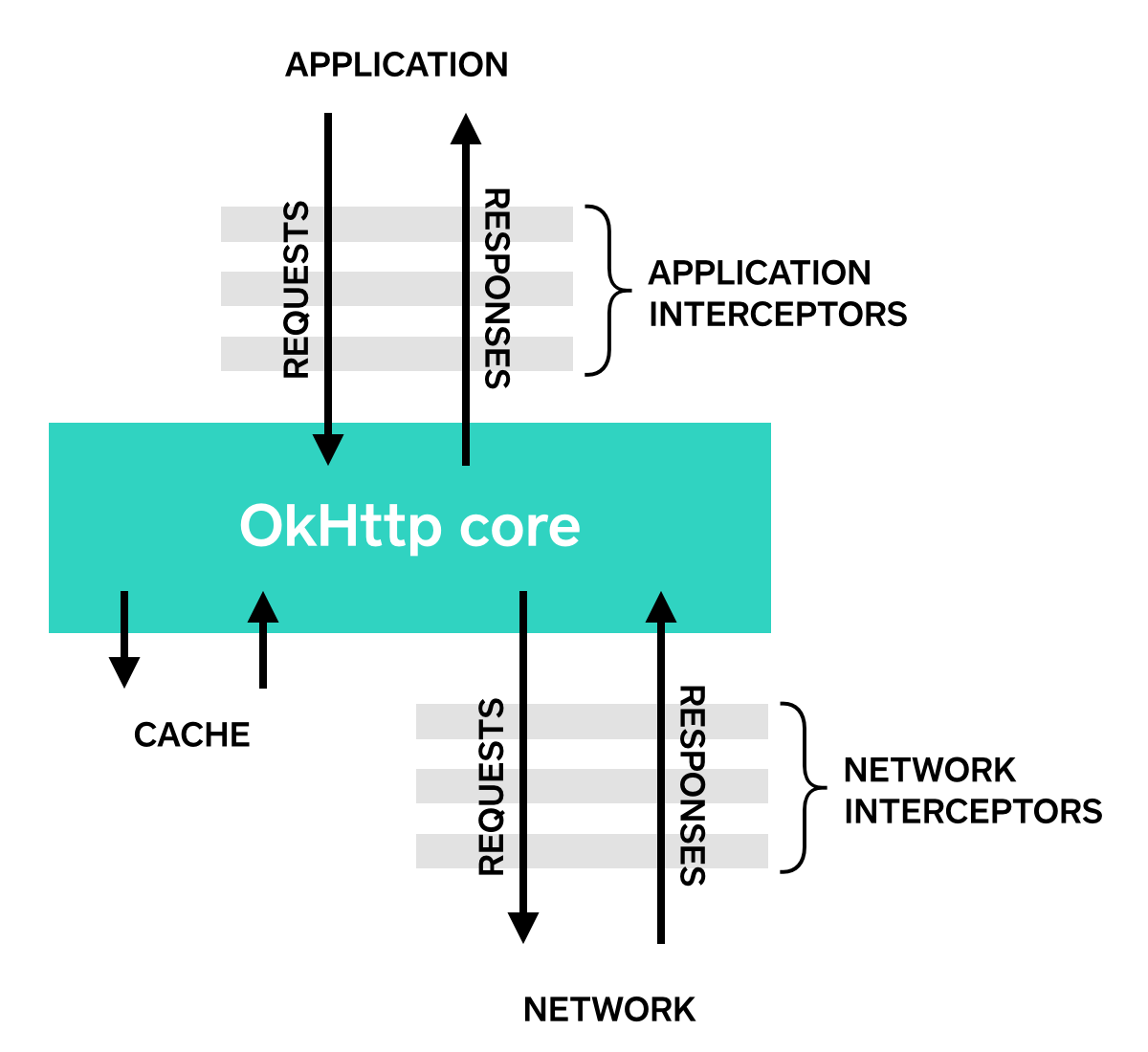学习OkHttp wiki--Interceptors
2016-07-21 18:00
615 查看
Interceptors
拦截器(Interceptors)是一种强有力的途径,来监控,改写和重试HTTP访问。下面是一个简单的拦截器,对流出的请求和流入的响应记录日志。class LoggingInterceptor implements Interceptor {
@Override public Response intercept(Chain chain) throws IOException {
Request request = chain.request();
long t1 = System.nanoTime();
logger.info(String.format("Sending request %s on %s%n%s",
request.url(), chain.connection(), request.headers()));
Response response = chain.proceed(request);
long t2 = System.nanoTime();
logger.info(String.format("Received response for %s in %.1fms%n%s",
response.request().url(), (t2 - t1) / 1e6d, response.headers()));
return response;
}
}在拦截器的实现中,对
chain.proceed(request)的一次调用时是关键的一步。这个看起来简单的方法是HTTP工作实际发生的地方,产生一个满足请求的响应。
多个拦截器可以链接起来。假如说你有一个压缩拦截器和一个求和校验拦截器:你将需要决定数据是先压缩然后求和校验,或者先求和校验再压缩。OkHttp使用列表来追踪拦截器,多个拦截器是被有序的调用。

Application Interceptors
拦截器被注册为应用(application)拦截器或者网络(network)拦截器。我们将用上面定义的LoggingInterceptor来展示这两者的区别。
要注册应用拦截器,在
OkHttpClient.interceptors()方法返回的列表上调用
add()方法:
OkHttpClient client = new OkHttpClient();
client.interceptors().add(new LoggingInterceptor());
Request request = new Request.Builder()
.url("http://www.publicobject.com/helloworld.txt")
.header("User-Agent", "OkHttp Example")
.build();
Response response = client.newCall(request).execute();
response.body().close();代码中的URL
http://www.publicobject.com/helloworld.txt重定向到
https://publicobject.com/helloworld.txt, OkHttp会自动跟随这一重定向。我们的应用拦截器会被调用一次,方法
chain.proceed()返回的响应是重定向后的响应:
INFO: Sending request http://www.publicobject.com/helloworld.txt on null User-Agent: OkHttp Example INFO: Received response for https://publicobject.com/helloworld.txt in 1179.7ms Server: nginx/1.4.6 (Ubuntu) Content-Type: text/plain Content-Length: 1759 Connection: keep-alive
我们可以通过
response.request().url()同
request.url()不同看出访问被重定向。这两个日志语句记录了两个不同了URL。
Network Interceptors
注册网络拦截器的方法很类似。添加拦截器到networkInterceptors()列表,取代
interceptors()列表:
OkHttpClient client = new OkHttpClient();
client.networkInterceptors().add(new LoggingInterceptor());
Request request = new Request.Builder()
.url("http://www.publicobject.com/helloworld.txt")
.header("User-Agent", "OkHttp Example")
.build();
Response response = client.newCall(request).execute();
response.body().close();当我们运行这一段代码时,拦截器执行了两次。一次是初始的到
http://www.publicobject.com/helloworld.txt的请求,另一次是重定向到
https://publicobject.com/helloworld.txt的请求。
INFO: Sending request http://www.publicobject.com/helloworld.txt on Connection{www.publicobject.com:80, proxy=DIRECT hostAddress=54.187.32.157 cipherSuite=none protocol=http/1.1} User-Agent: OkHttp Example Host: www.publicobject.com Connection: Keep-Alive Accept-Encoding: gzip INFO: Received response for http://www.publicobject.com/helloworld.txt in 115.6ms Server: nginx/1.4.6 (Ubuntu) Content-Type: text/html Content-Length: 193 Connection: keep-alive Location: https://publicobject.com/helloworld.txt INFO: Sending request https://publicobject.com/helloworld.txt on Connection{publicobject.com:443, proxy=DIRECT hostAddress=54.187.32.157 cipherSuite=TLS_ECDHE_RSA_WITH_AES_256_CBC_SHA protocol=http/1.1} User-Agent: OkHttp Example Host: publicobject.com Connection: Keep-Alive Accept-Encoding: gzip INFO: Received response for https://publicobject.com/helloworld.txt in 80.9ms Server: nginx/1.4.6 (Ubuntu) Content-Type: text/plain Content-Length: 1759 Connection: keep-alive
上面的网络请求也包含更多的数据,例如由OkHttp添加的请求头
Accept-Encoding: gzip,通知支持对响应的压缩。网络拦截器链有一个非空的连接,用来询问我们连接web服务器使用的IP地址和TLS配置。
选择应用拦截器还是网络拦截器
两个拦截器链有自身的相对优势。Application Interceptors
不用担心中间过程的响应,例如重定向和重试。
始终调用一次,即使HTTP响应来自于缓存。
观察应用原始的意图。不用关注由OkHttp注入的头信息,例如
If-None-Match。
允许短路,不调用
Chain.proceed()。
允许重试,多次调用
Chain.proceed()。
Network Interceptors
能操作中间响应,例如重定向和重试。
发生网络短路的缓存响应时,不被调用。
观察将通过网络传输的数据。
可以获取到携带请求的
connection。
改写请求
拦截器可以添加,移除或者替换请求头。它们也可以改变请求体。例如,如果你连接的web服务器支持,你可以用一个应用拦截器来压缩请求体。/** This interceptor compresses the HTTP request body. Many webservers can't handle this! */
final class GzipRequestInterceptor implements Interceptor {
@Override public Response intercept(Chain chain) throws IOException {
Request originalRequest = chain.request();
if (originalRequest.body() == null || originalRequest.header("Content-Encoding") != null) {
return chain.proceed(originalRequest);
}
Request compressedRequest = originalRequest.newBuilder()
.header("Content-Encoding", "gzip")
.method(originalRequest.method(), gzip(originalRequest.body()))
.build();
return chain.proceed(compressedRequest);
}
private RequestBody gzip(final RequestBody body) {
return new RequestBody() {
@Override public MediaType contentType() {
return body.contentType();
}
@Override public long contentLength() {
return -1; // We don't know the compressed length in advance!
}
@Override public void writeTo(BufferedSink sink) throws IOException {
BufferedSink gzipSink = Okio.buffer(new GzipSink(sink));
body.writeTo(gzipSink);
gzipSink.close();
}
};
}
}改写响应
对应的,拦截器也可以改写响应头和改变响应体。这通常来讲比改写请求头更危险,因为它可能违背了web服务器的预期。如果你在一个微妙的情境下,并准备好去处理对应的后果,改写响应头是一种有力的方式来解决问题。例如,你可以修复服务器错误配置的缓存控制响应头,来优化对响应的缓存。
/** Dangerous interceptor that rewrites the server's cache-control header. */
private static final Interceptor REWRITE_CACHE_CONTROL_INTERCEPTOR = new Interceptor() {
@Override public Response intercept(Chain chain) throws IOException {
Response originalResponse = chain.proceed(chain.request());
return originalResponse.newBuilder()
.header("Cache-Control", "max-age=60")
.build();
}
};通常来讲,这种方式在补充相应的服务器问题修复时最有用。
可用性
OkHttp拦截器需要2.2版本以上。不幸的是,拦截器对OkUrlFactory,和任何依赖
OkUrlFactory的库无效,包含Retrofit 1.8以下和Picasso 2.4版本以下。
相关文章推荐
- java网络编程:通过HTTPS协议传送xml文件交互
- HTTP报文结构图解
- 网络编程
- httpd 结合nfs部署
- 每日安全简讯20160721
- HttpURLConnection从网上下载图片
- 全面理解HTTP
- TCP/IP模型概述
- Windows Server 2012 虚拟化实战:网络(二)
- iOS NSURLCache(网络缓存)
- WIN764位 如何安装Microsoft LoopBack Adapter(Oracle10g安装时如何通过网络检测)---亲测可用
- 用Node.js创建自签名的HTTPS服务器
- http状态码有哪些?代表什么意思?(查询手册而已)
- 在github上传项目遇到的问题(error: failed to push some refs to 'https://github.com/CrazyDony/text.git')
- com.squareup.okhttp.Interceptor
- Windows Server 2012 虚拟化实战:网络(二)
- OKHttp使用详解及源码解析
- 浅析HTTP协议
- HTTP Header 详解
- MySQL 中NULL和空值的区别 (转载 http://blog.sina.com.cn/s/blog_3f2a82610102v4dn.html)
